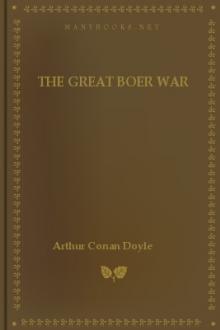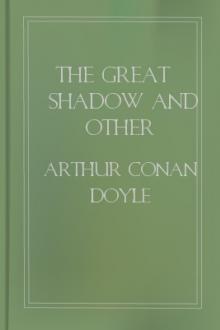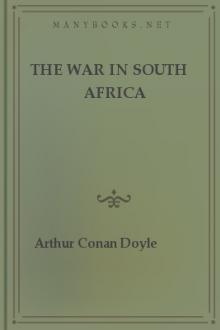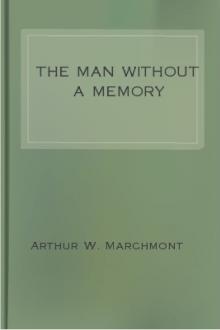The Great Boer War by Arthur Conan Doyle (smart ebook reader .txt) 📕

- Author: Arthur Conan Doyle
- Performer: -
Book online «The Great Boer War by Arthur Conan Doyle (smart ebook reader .txt) 📕». Author Arthur Conan Doyle
The first shock of the Boers, then, must fall upon 4000 men. If these could be overwhelmed, there were 8000 more to be defeated or masked. Then what was there between them and the sea? Some detachments of local volunteers, the Durban Light Infantry at Colenso, and the Natal Royal Rifles, with some naval volunteers at Estcourt. With the power of the Boers and their mobility it is inexplicable how the colony was saved. We are of the same blood, the Boers and we, and we show it in our failings. Over-confidence on our part gave them the chance, and over-confidence on theirs prevented them from instantly availing themselves of it. It passed, never to come again.
The outbreak of war was upon October 11th. On the 12th the Boer forces crossed the frontier both on the north and on the west. On the 13th they occupied Charlestown at the top angle of Natal. On the 15th they had reached Newcastle, a larger town some fifteen miles inside the border. Watchers from the houses saw six miles of canvas-tilted bullock wagons winding down the passes, and learned that this was not a raid but an invasion. At the same date news reached the British headquarters of an advance from the western passes, and of a movement from the Buffalo River on the east. On the 13th Sir George White had made a reconnaissance in force, but had not come in touch with the enemy. On the 15th six of the Natal Police were surrounded and captured at one of the drifts of the Buffalo River. On the 18th our cavalry patrols came into touch with the Boer scouts at Acton Homes and Besters Station, these being the voortrekkers of the Orange Free State force. On the 18th also a detachment was reported from Hadders Spruit, seven miles north of Glencoe Camp. The cloud was drifting up, and it could not be long before it would burst.
Two days later, on the early morning of October 20th, the forces came at last into collision. At half-past three in the morning, well before daylight, the mounted infantry picket at the junction of the roads from Landmans and Vants Drifts was fired into by the Doornberg commando, and retired upon its supports. Two companies of the Dublin Fusiliers were sent out, and at five o’clock on a fine but misty morning the whole of Symons’s force was under arms with the knowledge that the Boers were pushing boldly towards them. The khaki-clad lines of fighting men stood in their long thin ranks staring up at the curves of the saddle-back hills to the north and east of them, and straining their eyes to catch a glimpse of the enemy. Why these same saddle-back hills were not occupied by our own people is, it must be confessed, an insoluble mystery. In a hollow on one flank were the 18th Hussars and the mounted infantry.
On the other were the eighteen motionless guns, limbered up and ready, the horses fidgeting and stamping in the raw morning air.
And then suddenly—could that be they? An officer with a telescope stared intently and pointed. Another and another turned a steady field glass towards the same place. And then the men could see also, and a little murmur of interest ran down the ranks.
A long sloping hill—Talana Hill—olive-green in hue, was stretching away in front of them. At the summit it rose into a rounded crest. The mist was clearing, and the curve was hard-outlined against the limpid blue of the morning sky. On this, some two and a half miles or three miles off, a little group of black dots had appeared. The clear edge of the skyline had become serrated with moving figures. They clustered into a knot, then opened again, and then—
There had been no smoke, but there came a long crescendo hoot, rising into a shrill wail. The shell hummed over the soldiers like a great bee, and sloshed into soft earth behind them. Then another—and yet another—and yet another. But there was no time to heed them, for there was the hillside and there the enemy. So at it again with the good old murderous obsolete heroic tactics of the British tradition! There are times when, in spite of science and book-lore, the best plan is the boldest plan, and it is well to fly straight at your enemy’s throat, facing the chance that your strength may fail before you can grasp it. The cavalry moved off round the enemy’s left flank. The guns dashed to the front, unlimbered, and opened fire. The infantry were moved round in the direction of Sandspruit, passing through the little town of Dundee, where the women and children came to the doors and windows to cheer them. It was thought that the hill was more accessible from that side. The Leicesters and one field battery—the 67th—were left behind to protect the camp and to watch the Newcastle Road upon the west. At seven in the morning all was ready for the assault.
Two military facts of importance had already been disclosed. One was that the Boer percussion-shells were useless in soft ground, as hardly any of them exploded; the other that the Boer guns could outrange our ordinary fifteen-pounder field gun, which had been the one thing perhaps in the whole British equipment upon which we were prepared to pin our faith. The two batteries, the 13th and the 69th, were moved nearer, first to 3000, and then at last to 2300
yards, at which range they quickly dominated the guns upon the hill. Other guns had opened from another crest to the east of Talana, but these also were mastered by the fire of the 13th Battery. At 7.30 the infantry were ordered to advance, which they did in open order, extended to ten paces. The Dublin Fusiliers formed the first line, the Rifles the second, and the Irish Fusiliers the third.
The first thousand yards of the advance were over open grassland, where the range was long, and the yellow brown of the khaki blended with the withered veld. There were few casualties until the wood was reached, which lay halfway up the long slope of the hill. It was a plantation of larches, some hundreds of yards across and nearly as many deep. On the left side of this wood—that is, the left side to the advancing troops—there stretched a long nullah or hollow, which ran perpendicularly to the hill, and served rather as a conductor of bullets than as a cover. So severe was the fire at this point that both in the wood and in the nullah the troops lay down to avoid it. An officer of Irish Fusiliers has narrated how in trying to cut the straps from a fallen private a razor lent him for that purpose by a wounded sergeant was instantly shot out of his hand. The gallant Symons, who had refused to dismount, was shot through the stomach and fell from his horse mortally wounded. With an excessive gallantry, he had not only attracted the enemy’s fire by retaining his horse, but he had been accompanied throughout the action by an orderly bearing a red pennon. ‘Have they got the hill?
Have they got the hill?’ was his one eternal question as they carried him dripping to the rear. It was at the edge of the wood that Colonel Sherston met his end.
From now onwards it was as much a soldiers’ battle as Inkermann. In the shelter of the wood the more eager of the three battalions had pressed to the front until the fringe of the trees was lined by men from all of them. The difficulty of distinguishing particular regiments where all were clad alike made it impossible in the heat of action to keep any sort of formation. So hot was the fire that for the time the advance was brought to a standstill, but the 69th battery, firing shrapnel at a range of 1400 yards, subdued the rifle fire, and about half-past eleven the infantry were able to push on once more.
Above the wood there was an open space some hundreds of yards across, bounded by a rough stone wall built for herding cattle. A second wall ran at right angles to this down towards the wood. An enfilading rifle fire had been sweeping across this open space, but the wall in front does not appear to have been occupied by the enemy, who held the kopje above it. To avoid the cross fire the soldiers ran in single file under the shelter of the wall, which covered them to the right, and so reached the other wall across their front. Here there was a second long delay, the men dribbling up from below, and firing over the top of the wall and between the chinks of the stones. The Dublin Fusiliers, through being in a more difficult position, had been unable to get up as quickly as the others, and most of the hard-breathing excited men who crowded under the wall were of the Rifles and of the Irish Fusiliers. The air was so full of bullets that it seemed impossible to live upon the other side of this shelter. Two hundred yards intervened between the wall and the crest of the kopje. And yet the kopje had to be cleared if the battle were to be won.
Out of the huddled line of crouching men an officer sprang shouting, and a score of soldiers vaulted over the wall and followed at his heels. It was Captain Connor, of the Irish Fusiliers, but his personal magnetism carried up with him some of the Rifles as well as men of his own command. He and half his little forlorn hope were struck down—he, alas! to die the same night—but there were other leaders as brave to take his place.
‘Forrard away, men, forrard away!’ cried Nugent, of the Rifles.
Three bullets struck him, but he continued to drag himself up the boulder-studded hill. Others followed, and others, from all sides they came running, the crouching, yelling, khaki-clad figures, and the supports rushed up from the rear. For a time they were beaten down by their own shrapnel striking into them from behind, which is an amazing thing when one considers that the range was under 2000
yards. It was here, between the wall and the summit, that Colonel Gunning, of the Rifles, and many other brave men met their end, some by our own bullets and some by those of the enemy; but the Boers thinned away in front of them, and the anxious onlookers from the plain below saw the waving helmets on the crest, and learned at last that all was well.
But it was, it must be confessed, a Pyrrhic victory. We had our hill, but what else had we? The guns which had been silenced by our fire had been removed from the kopje. The commando which seized the hill was that of Lucas Meyer, and it is computed that he had with him about 4000 men. This figure includes those under the command of Erasmus, who made halfhearted demonstrations





Comments (0)